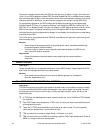
48 S-ICX (International) issued October 2000 S-ICX-50-200
Benefits:
• The Attendant position isn’t limited to just one phone. Different phones can act as the
system operator position, depending on the time of day.
• Other phones can serve as backup positions for the Attendant phone.
AUTO-REPEAT DIALING
Description:
If a user places an outside phone call and gets a busy tone, he/she can stay on the line and
press REDIAL. The S-ICX will automatically send a Flash signal, redial the call, and wait to
detect busy tone on the line (note: this doesn’t work on AC15 tie-lines or ground-start trunks). If
the line is still busy, the system will try again and again, at programmable intervals, until one of
the following happens (whichever occurs first): 1) the called party answers; 2) the user hangs up;
or 3) the system tries 14 more times.
You can turn this feature on/off for individual extensions, and also enable/disable it on individual
trunks. You can also program the amount of time the system waits to detect busy or answer, as
well as the interval between redial attempts.
Benefits:
• An automatic feature that helps phone users save time and reduce dialing errors.
BACKGROUND MUSIC (BGM)
Description:
Users can set their phones to play Background Music on-speaker while the phone is idle. If the
phone receives a call, or the user goes off-hook, BGM will go away until the phone becomes idle
again. BGM can be turned off by dialing the same code that turned it on. It can have a different
sound source than Music-On-Hold (MOH) only when used with the CPC-HM.
Applications:
• One sound source for employees (BGM, typically music), another for callers (MOH,
such as recorded advertisements).
BUSY OVERRIDE (“BARGE-IN”)
Description:
An extension user can barge into a call on another extension, whether it’s an outside or intercom
call. Phones set to Do-Not-Disturb (DND) can also be barged into; see DO NOT DISTURB for
more information.
When a barge-in occurs, a 3-party conference call is created; all three parties can hear each
other and talk to each other. There are two ways to barge-in on a call:
❣ Extension Busy Override, where the user dials the extension, gets busy tone, and dials a
code to barge-in.
❣ Exchange Line Key Busy Override, where the user presses the lit exchange line key on
his/her phone that represents the call in progress.
You can program the S-ICX to send an alert tone to all parties when the barge-in occurs. You can
also allow/block the phone’s ability to perform this feature based on the phone’s Class of Service
assignment (see CLASS OF SERVICE RESTRICTION in Chapter 3 - System Features for more
information).


















